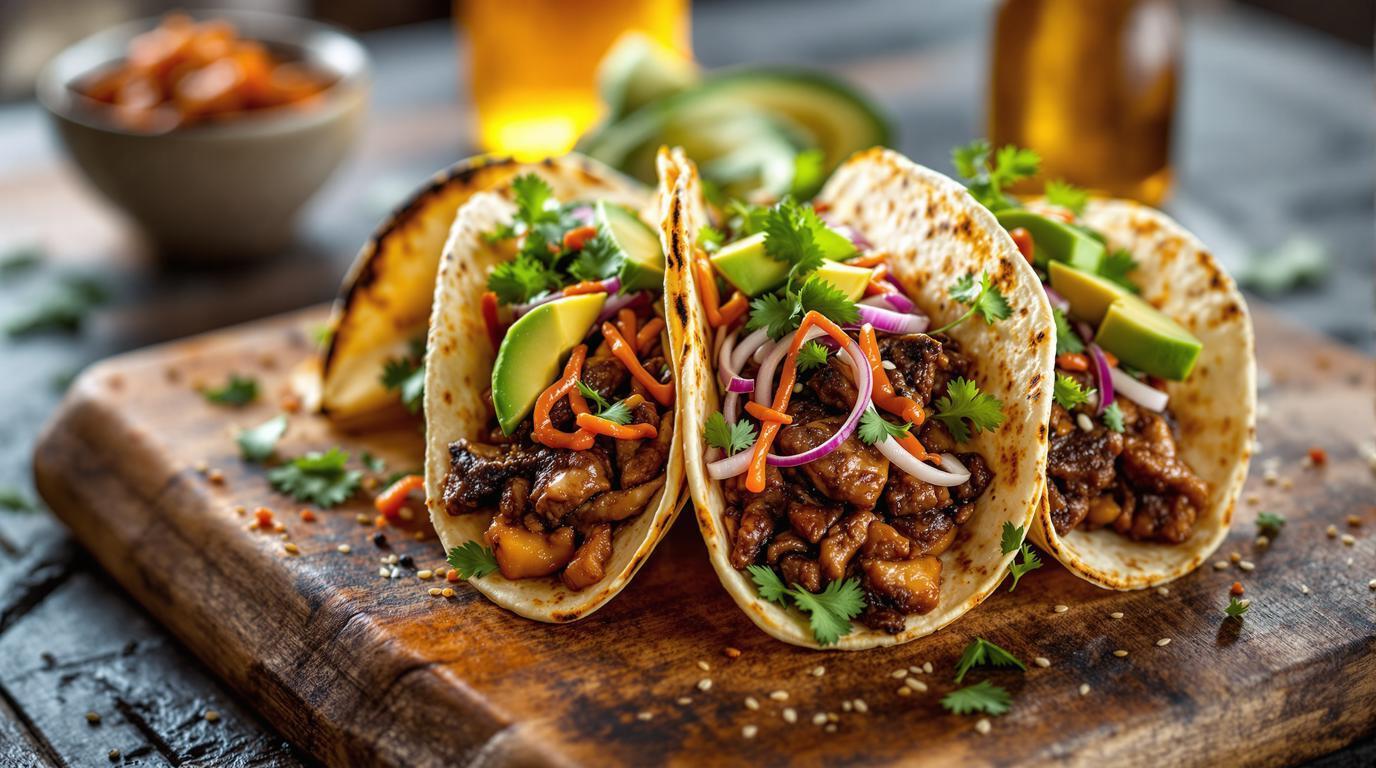It was during my stint at a Seoul food market that I first encountered the revelation that is kimchi tacos. The marriage of fermented, funky kimchi with tender bulgogi beef completely rewired my understanding of fusion cuisine. What makes this dish exceptional isn’t just the collision of Korean and Mexican influences, but how the caramelization of kimchi transforms its sharp edges into something mellow yet complex. That first bite delivered an explosion of umami, tang, and subtle sweetness that I’ve spent years trying to perfect in my own kitchen. Now, I’m thrilled to share my definitive version with you.
The Story 📖
Kimchi tacos emerged from the vibrant Korean-Mexican food scene in Los Angeles around 2008, pioneered by chef Roy Choi’s Kogi BBQ truck. What began as a creative solution during economic hardship evolved into a culinary phenomenon that honors both traditions without diminishing either. The genius lies in how the fermented depth of kimchi cuts through the richness of bulgogi, while warm corn tortillas provide the perfect neutral canvas. I’ve refined this recipe through countless tests, focusing on achieving that perfect balance where each element retains its identity while creating something entirely new.
Ingredients Spotlight 🧪
For the bulgogi beef (serves 4):
- 1 lb (450g) ribeye or beef brisket, sliced paper-thin
- 3 tablespoons (45ml) soy sauce
- 2 tablespoons (25g) brown sugar
- 1 tablespoon (15ml) mirin
- 2 teaspoons (10ml) sesame oil
- 3 garlic cloves, minced
- 1 tablespoon (15g) grated Asian pear (or apple in a pinch)
- 1 tablespoon (5g) grated ginger
For the caramelized kimchi:
- 1 cup (150g) cabbage kimchi, chopped
- 1 tablespoon (15ml) neutral oil
- 1 teaspoon (5ml) sesame oil
- 1 tablespoon (12g) brown sugar
For assembly:
- 12 small corn tortillas (6-inch/15cm)
- 1 small red onion, thinly sliced
- Fresh cilantro, roughly chopped
- 1 avocado, sliced
- Lime wedges
- Toasted sesame seeds
For the sriracha mayo (optional):
- ¼ cup (60ml) mayonnaise
- 2 tablespoons (30ml) sriracha
- 1 teaspoon (5ml) lime juice
Step-by-Step Guide 📝
1. Marinate the beef – Combine all marinade ingredients in a bowl. Add beef slices, toss thoroughly, and let marinate for at least 30 minutes (overnight is better). The pear acts as both a sweetener and tenderizer, breaking down muscle fibers through enzymatic action.
2. Caramelize the kimchi – Heat oils in a skillet over medium heat (325°F/160°C). Add kimchi and brown sugar, stirring frequently for 8-10 minutes until the edges brown and the flavor mellows. The sugar accelerates caramelization while taming kimchi’s acidity.
3. Cook the bulgogi – Heat a heavy skillet or grill to medium-high (375°F/190°C). Working in batches to avoid crowding, cook beef for 2-3 minutes per side until edges are caramelized but center remains juicy. Rest 5 minutes before serving.
4. Warm tortillas – Heat tortillas in a dry skillet for 30 seconds per side or wrap in damp paper towels and microwave for 30 seconds. Keep warm in a clean kitchen towel.
5. Assemble tacos – Layer beef, kimchi, red onion, cilantro, and avocado on tortillas. Drizzle with sriracha mayo if using, and finish with sesame seeds and a squeeze of lime.
Expert Techniques 🛠️
The key to exceptional bulgogi lies in the meat’s thickness – request your butcher to slice it paper-thin (about 1/8-inch/3mm) or partially freeze the meat for 30 minutes before slicing yourself. The marinade should coat every piece, creating a glossy finish that caramelizes beautifully when cooked.
When caramelizing kimchi, patience is crucial. As moisture evaporates, watch for the moment when the edges begin to darken and the aroma shifts from sharp to sweet-savory. This transformation tames kimchi’s funk while concentrating its umami qualities.
Chef’s Note: Aged kimchi (at least 2-3 weeks old) caramelizes better than fresh, offering deeper flavor complexity and more developed acidity. If using store-bought, look for packages with a slight bulge – this indicates active fermentation.
Presentation & Pairing Ideas 🍽️
Serve tacos family-style with all components in separate bowls, allowing guests to build their own. This interactive approach honors the communal spirit of both Korean and Mexican dining traditions. For beverages, Korean soju cuts through the richness perfectly, while a floral Gewürztraminer provides beautiful contrast to the spice. For a non-alcoholic option, try a sparkling yuzu drink.
For seasonal variations, incorporate kimchi radish in spring, kimchi cucumber in summer, and kimchi mushrooms in fall. Vegetarians can substitute the beef with marinated mushrooms or firm tofu using the same marinade, adjusting cooking time to 2 minutes per side.
The kimchi-bulgogi combination also works brilliantly in other formats: try it in fusion rice bowls, as a topping for crispy potato pancakes, or even as a decadent filling for grilled cheese sandwiches. And for dessert? Nothing complements these bold flavors better than a cool, creamy cheesecake.
Remember, the heart of this recipe isn’t rigid authenticity but respectful innovation. Make it your own by adjusting heat levels, adding pickled vegetables, or experimenting with different proteins. The true magic happens when you understand the principles behind the technique – then you’re cooking not just with ingredients, but with intention.
